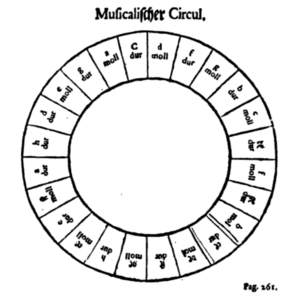Johann David Heinichen facts for kids
Quick facts for kids
Johann David Heinichen
|
|
|---|---|
| Born | April 17, 1683 Teuchern, Saxony-Anhalt, Germany
|
| Died | July 16, 1729 (aged 46) |
| Known for | Circle of fifths |
| Children | 1 |
Johann David Heinichen (born April 17, 1683 – died July 16, 1729) was a German Baroque composer and music expert. He was known for bringing the exciting music style of Venice to the royal court in Dresden, Germany. After he passed away, his music wasn't very famous for a long time. Heinichen is also remembered as one of the people who helped create the idea of the circle of fifths, which is a way to understand how musical keys are related.
Contents
About Johann David Heinichen
Johann David Heinichen was born in a small village called Krössuln. This village is now part of Teuchern in Germany. His father, Michael Heinichen, was a church musician and a pastor. Johann David also went to the Thomasschule Leipzig, a famous school where he studied music. He learned from great teachers like Johann Schelle and Johann Kuhnau. Another famous composer, Christoph Graupner, also studied with Kuhnau at the same time.
His Education and Early Career
In 1702, Heinichen went to the University of Leipzig to study law. By 1705, he became a qualified lawyer. Back then, many composers, like Kuhnau and Georg Philipp Telemann, also studied law. Heinichen worked as a lawyer in a town called Weissenfels until 1709.
Even though he was a lawyer, Heinichen loved music and kept composing operas. In 1710, he published an important book about music theory. After this, he traveled to Italy and spent seven important years there. He lived mostly in Venice and had great success with two operas, Mario and Le passioni per troppo amore.
Working for Royalty
In 1712, Heinichen taught music to Leopold, Prince of Anhalt-Köthen. This same prince later hired Johann Sebastian Bach as his main musician. In 1716, while in Venice, Heinichen met Prince Augustus III of Poland. Thanks to this meeting, Heinichen was hired as the main court musician, or Kapellmeister, in Dresden. One of his students there was Johann Georg Pisendel, who became a famous violinist.
In 1721, Heinichen got married. His only child was born in January 1723. In his last years, Heinichen was very sick. He passed away on July 16, 1729, and was buried in the Johannes cemetery.
Rediscovering His Music
For many years after his death, Heinichen's music was not well known. But after 1992, a music group called Musica Antiqua Köln started recording his works. They recorded many of his concertos and other pieces. His only opera for Dresden, Flavio Crispo, was never performed when he was alive, but it was finally recorded in 2018. Thanks to these recordings, more people today can enjoy Johann David Heinichen's wonderful music.
The Circle of Fifths
Heinichen is known for creating his own version of the circle of fifths. He wrote about it in his book Neu erfundene und gründliche Anweisung (1711). The circle of fifths is a way to show how different musical keys are related to each other. It helps musicians understand how to change keys smoothly in a song.
Heinichen wasn't the very first person to invent this idea. Another musician, Nikolay Diletsky, had a similar idea in the 1670s, but Heinichen didn't know about it. Heinichen did give credit to Athanasius Kircher and his book Musurgia universalis (1650) as an earlier influence on his musical ideas.
Works list
See also
 In Spanish: Johann David Heinichen para niños
In Spanish: Johann David Heinichen para niños


